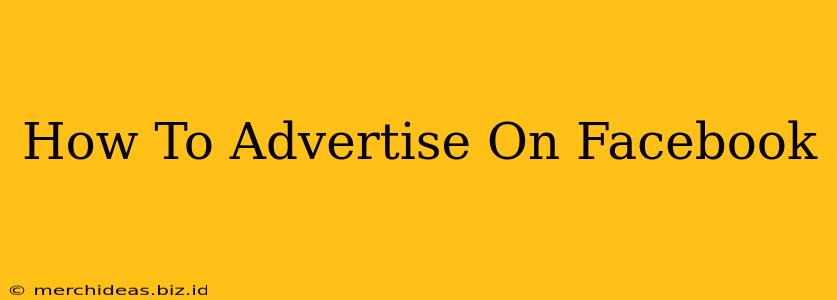Facebook advertising can be a powerful tool for reaching your target audience and boosting your business. But with so many options and features, it can feel overwhelming for newcomers. This comprehensive guide will walk you through the process, from setting up your account to analyzing your results.
Understanding Facebook Ads Manager
Before you even think about creating your first ad, you need to familiarize yourself with Facebook Ads Manager. This is the central hub for all your Facebook advertising activities. Here, you'll create campaigns, set budgets, target your audience, and track your performance. Think of it as your mission control for Facebook advertising success.
Key Features of Ads Manager:
- Campaigns: This is where you define your overall advertising objective, whether it's brand awareness, website traffic, or conversions.
- Ad Sets: Within each campaign, you'll create ad sets to target specific audiences with different parameters like location, age, interests, and behaviors.
- Ads: This is where you create the actual visual and textual elements of your advertisement. You can A/B test different versions to see which performs best.
Defining Your Advertising Objectives
Before diving into the specifics, it's crucial to define your goals. What do you want to achieve with your Facebook advertising campaign? Are you trying to:
- Increase Brand Awareness? Focus on reach and engagement.
- Drive Website Traffic? Optimize for clicks to your website.
- Generate Leads? Use lead generation forms directly within Facebook.
- Boost Sales? Focus on conversions and retargeting.
Clearly defining your objective will inform every subsequent step in the process, ensuring you're allocating resources effectively.
Targeting Your Audience: The Key to Success
Facebook's strength lies in its sophisticated targeting options. You can reach incredibly specific audiences based on a wide range of factors, including:
- Demographics: Age, gender, location, language, education, and relationship status.
- Interests: Pages they like, groups they join, and events they attend.
- Behaviors: Purchasing habits, digital activity, and device usage.
- Custom Audiences: Upload your existing customer lists to target them with specific messaging.
- Lookalike Audiences: Create audiences similar to your existing customers.
Pro-Tip: Don't be afraid to experiment with different targeting options to find what works best for your business. Start broad, then refine your targeting based on your initial results.
Creating Compelling Ad Creatives
Your ad's visuals and copy are just as important as your targeting. A poorly designed ad, no matter how well-targeted, will fail to convert. Consider these elements:
- High-Quality Images or Videos: Use visually appealing and relevant content that grabs attention.
- Concise and Engaging Copy: Get straight to the point and highlight the benefits of your product or service.
- Clear Call to Action: Tell users exactly what you want them to do (e.g., "Shop Now," "Learn More," "Sign Up").
A/B Testing is Crucial: Experiment with different variations of your ad creatives to see which performs best. Test different headlines, images, and calls to action.
Setting Your Budget and Bidding Strategy
Facebook offers various budgeting options, including daily budgets and lifetime budgets. Choose the option that best suits your needs and resources. Your bidding strategy will determine how much you pay for each ad interaction. Common strategies include:
- Cost per Click (CPC): You pay only when someone clicks on your ad.
- Cost per Mille (CPM): You pay per 1,000 impressions (times your ad is shown).
Selecting the right bidding strategy depends on your campaign goals.
Tracking and Analyzing Your Results
Once your campaign is running, regularly monitor its performance. Facebook Ads Manager provides detailed analytics, allowing you to track key metrics such as:
- Reach: How many people saw your ad.
- Engagement: How people interacted with your ad (likes, comments, shares).
- Website Clicks: How many people clicked through to your website.
- Conversions: How many people completed a desired action (e.g., made a purchase).
Use this data to optimize your campaigns, making adjustments to your targeting, creatives, and bidding strategy as needed.
Conclusion: Mastering Facebook Advertising
Facebook advertising is a dynamic and constantly evolving landscape. By understanding the platform's features, mastering targeting options, and continuously analyzing your results, you can effectively reach your target audience and achieve your business goals. Remember, consistent optimization and experimentation are key to long-term success.
